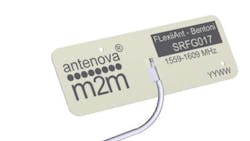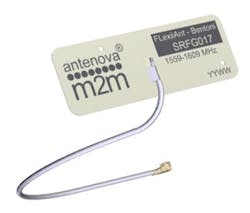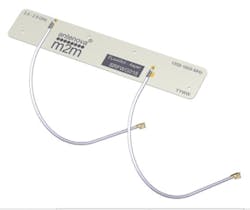Flexible Antennas Look to the Sky
This file type includes high-resolution graphics and schematics when applicable.
Navigation by satellite is becoming commonplace, so much so that an increasing number of electronic devices are being equipped with receivers for Global Positioning System (GPS) and other satellite navigation constellations. Creating that kind of satellite access requires a compact antenna. And when there’s a demand for a flexible antenna (such as for wearable devices), too, a pair of miniature, flexible-printed-circuit (FPC), linearly polarized antennas from Antenova might do the trick.
The antennas, which weigh only 0.5 g each, meet the needs of GPS, GLONASS, and GALILEO systems while. The Bentoni Global Navigation Satellite System (GNSS) antenna operates from 1559 to 1609 MHz, while the Asper2.4G/GNSS antenna can be used at both 1559 to 1609 MHz and 2400 to 2500 MHz. They’re well-suited for satellite navigation and wireless-connectivity applications, including for machine-to-machine (M2M) and Internet of Things (IoT) connections. Compact to start with, the antennas can also be folded within a final product design to further save space.
Single-Band Bentoni
The single-frequency-band model SRFG017 Bentoni antenna (Fig. 1) measures just 40.0 × 14.0 × 0.15 mm and weighs less than 0.5 g. The basic model has three variations—1.13- mm-diameter RF cable lengths of 50, 100, or 150 mm—each terminated with an IPEX MHF connector for ease of installation with a host printed circuit board (PCB).
Targeted at everything from portable and wearable devices to unmanned aerial vehicles (UAVs), the miniature antenna provides better than 75% average efficiency from 1559 to 1609 MHz. It achieves 4-dBi peak gain and –1.2-dBi average gain across its frequency range, with maximum return loss of –14 dB and maximum VSWR of 1.45:1.
Dual-Band Asper
The dual-frequency-band model SRFWG018 Asper antenna operates at both 1509 to 1669 MHz and 2.4 to 2.5 GHz (Fig. 2). It measures a mere 81 × 14 × 0.15 mm and weighs less than 0.5 g, yet achieves average efficiency of better than 75% in the lower frequency band and better than 85% in the upper frequency band. It also comes in three different lengths of 1.13-mm-diameter RF cable (one for each frequency band)—100, 150, or 200 mm—each terminated with an IPEX MHF connector for ease of integration with host circuitry.
The Asper antenna delivers 4.25-dBi peak gain and –1.1-dBi average gain across the lower-frequency band and 5.60-dBi peak gain and –0.6-dBi average gain across the higher-frequency band. Maximum return loss is –18.4 dB across the lower-frequency band and –14.5 dB from 2.4 to 2.5 GHz. Maximum VSWR is 1.30:1 across the lower-frequency band and 1.40:1 across the higher-frequency band.
Both FPC antennas maintain high isolation within the device or package to which they are mounted. Each exhibits characteristic impedance of 50 ⦠and can be used over operating temperatures from –40 to +85°C. Self-adhesive mounting eases installation with a host PCB and product packaging. At roughly the same size and weight, the antennas provide system integrators and product developers with the option of adding wireless-connectivity capability, such as Bluetooth or Wi-Fi, to a satellite navigation product, saving a great deal of board space in the process.
Antenova Ltd., 2nd Floor, Titan Court, Bishop Square, Hatfield, AL10 9NA United Kingdom;+44 (0) 1233 810600, e-mail: [email protected]
About the Author
Jack Browne
Technical Contributor
Jack Browne, Technical Contributor, has worked in technical publishing for over 30 years. He managed the content and production of three technical journals while at the American Institute of Physics, including Medical Physics and the Journal of Vacuum Science & Technology. He has been a Publisher and Editor for Penton Media, started the firm’s Wireless Symposium & Exhibition trade show in 1993, and currently serves as Technical Contributor for that company's Microwaves & RF magazine. Browne, who holds a BS in Mathematics from City College of New York and BA degrees in English and Philosophy from Fordham University, is a member of the IEEE.



